Complete Guide to Stone Fruit
- By The FruitGuys
- Reading Time: 4 mins.
Everything you always wanted to know about stone fruit (but were afraid to ask)
Here’s a primer on some of our favorite stone fruit, from peaches to nectarines to apricots, and plums, from peach-like fruit to plum-like fruit.
Cling. Semi-cling. And Free-stone. Stone fruit that is woven into the pit is called “cling.” Fruit that has less fiber woven into the pit is called “semi-cling.” And fruit that is free of the pit is called “free-stone.”
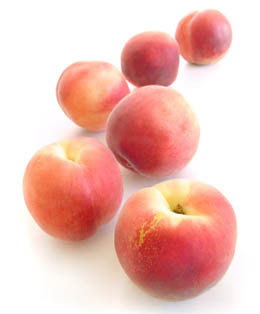 White Peach
White Peach
Peaches and nectarines are from the same family—genetically they’re identical except that nectarines have a recessive gene that makes their skin fuzz-less. Peaches come to us from China, via the Persians, along the trade routes of the Silk Road. The Chinese believed that peaches could confer immortality, but The FruitGuys only promise that they’re high in antioxidants Vitamin A and C. Ripeness in peaches and peach-like fruit can be judged from both touch and smell. The aroma will increase as it nears perfection, and the skin will yield slightly when you squeeze it.
Yellow Peach
To easily remove peach skin, you can drop peaches in boiling water for 10–15 seconds then quickly remove them and dunk in cold water. The skin will almost “slide off” if you peel it after this process. Of course, the surface of stone fruit, in general, is where many of the nutrients lie and, especially in particular plums, where the mix of sweet and tartness combine. Red color on peaches is an indication of more sunlight and thus more sugar in the fruit.
Want fruit for your office?
Get your office a free sample TODAY!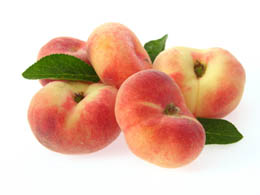 Saturn or Donut Peach
Saturn or Donut Peach
These squat, white-fleshed peaches are called by many names: you may hear them referred to as a Donut Peach, Saturn Peach, Saucer Peach, or even Frisbee Peach (actually I just made that one up, but you can use it if you’d like.) They generally run up to 3 1/2 inches in diameter with a smooth, round look that draws down and in at the center. The skin will be a pale yellow with a red blush. You can judge ripeness on this peach from both touch and smell. The aroma will increase as it nears perfection, and the skin will yield when you squeeze it. I find that you don’t want to let this fruit get too soft but should eat it when it begins to give to your touch but still has some firmness. These unique white peaches will be succulent and sweet.
White Nectarine
Nectarines are a peach-like fruit but without the fuzz! Nectarines ARE peaches but with a recessive gene that makes them a little sweeter and with smooth, fuzzless skin. Cut down the seam, twist and separate for freestone varieties; use a serrated knife to cut wedges out of cling or semi-cling varieties. White nectarines tend to be sweeter than yellow nectarines.
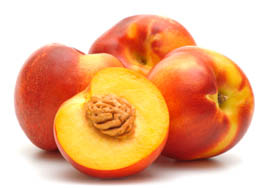 Yellow Nectarine
Yellow Nectarine
Yellow nectarines tend to have more acid than white nectarines for a sharper sweet taste.
Mango Nectarine
Mango Nectarines have a wonderfully unique texture and taste. When ripe it is rich and soft like a mango that melts on your tongue and lingers with a demure honey-perfumed flavor. They are best when they begin to soften to the touch. The Mango Nectarine is believed to be a cross of two old-variety pale nectarines. Early California nectarines were green-skinned and white-fleshed. They were small but produced sweet–tasting varieties like the John Rivers, Gower, and Quetta. The look of the modern red-skinned nectarine came about in 1942 when Fred W. Anderson of Le Grand, Calif., introduced the Le Grand Nectarine. Since then, nectarines have been grown for deeper red color and larger sizes.
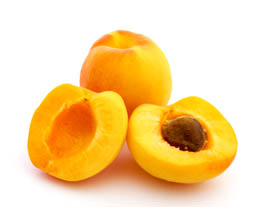 White Apricot
White Apricot
The white apricot is a hybridized cross between a Moroccan and an Iranian apricot. It has a very pale-yellow skin color with a slightly-speckled and nearly peach-like blush at the top. The fruit inside is so juicy and refreshing that it tastes like some impossible combination of warm-apricot sorbet. When ready to eat, it has the juiciness and smooth texture of a perfectly-ripened peach but with a unique and indelible lightness.
Aprium
Apriums are 2/3 apricot and 1/3 plum. You should eat them when soft to the touch but don’t let them get too soft or mushy as they will quickly move past their prime. Apriums look like apricots but also have a sweet and tart bite to them like early plums.
Want farm-fresh fruit?
We've got you covered.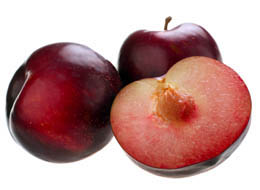 Red Plum
Red Plum
The red plum variety has a unique appearance with sweet, juicy red flesh. The contrast of tastes between the skin and the flesh make them a refreshing choice. Some people prefer them firm.
Pluot
Pluots are a cross hybrid of plum and apricot, exhibiting more plum-like traits. They usually exhibit purple skin and dark red flesh.
FAQs
- How can I tell if stone fruit is ripe?
Ripe stone fruit will have a slight give when squeezed gently and emit a sweet aroma. - What’s the difference between peaches and nectarines?
They’re genetically identical, but nectarines have a recessive gene that gives them fuzz-free skin. - What’s the best way to cut stone fruit?
Use a knife to cut freestone varieties to the pit, following the seam around the fruit. Then, twist the two halves to separate them. For stubborn cling and semi-cling varieties, follow the same method but use a serrated knife to cut through the fibers holding the pit in place.


